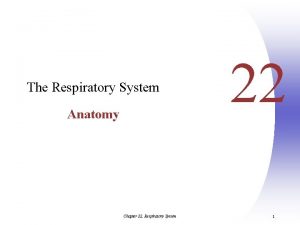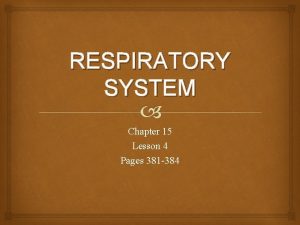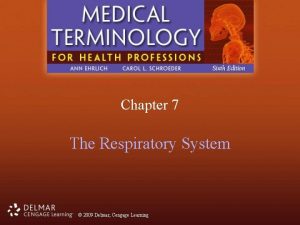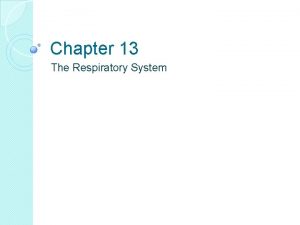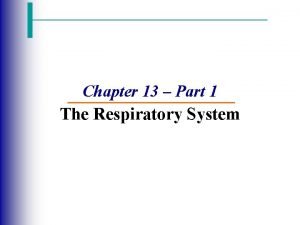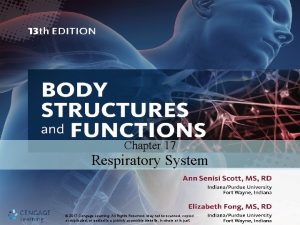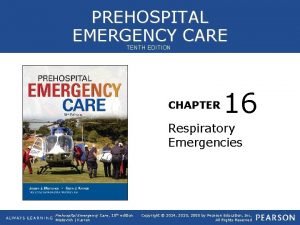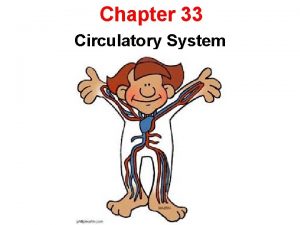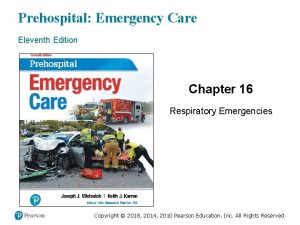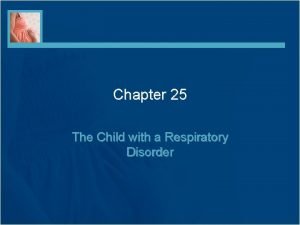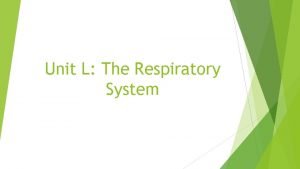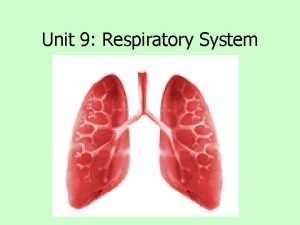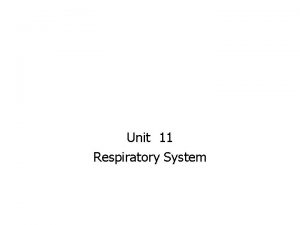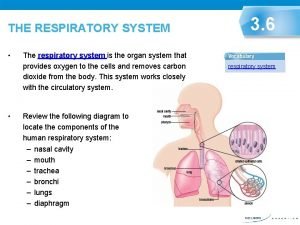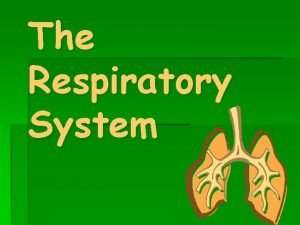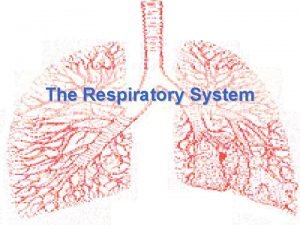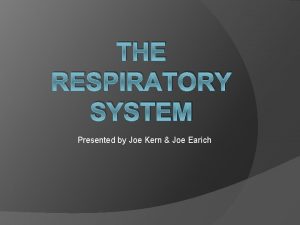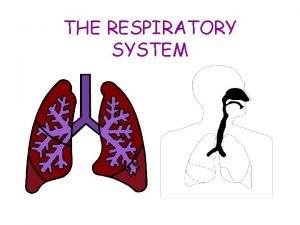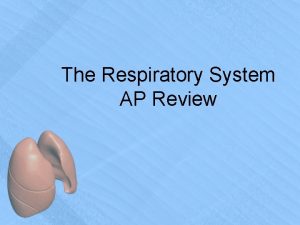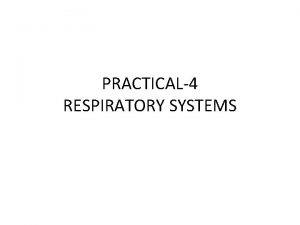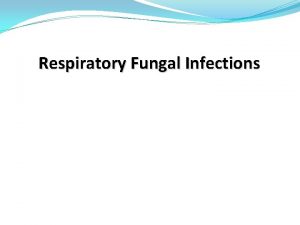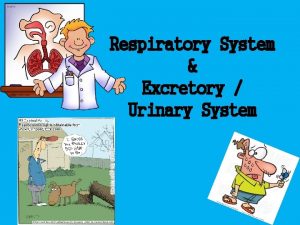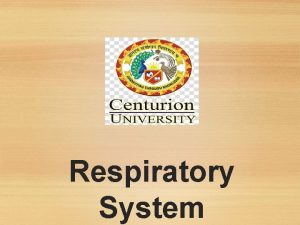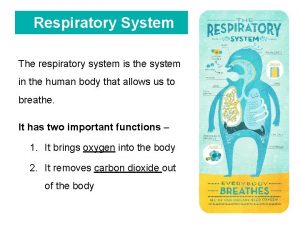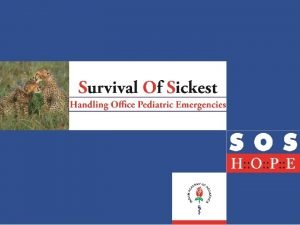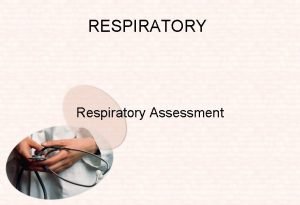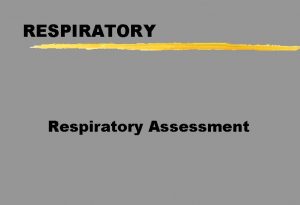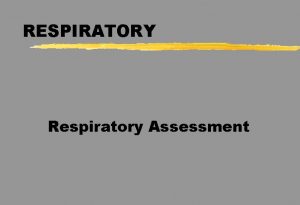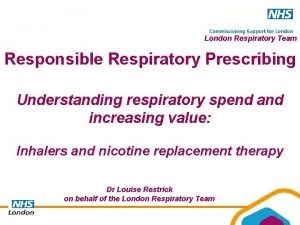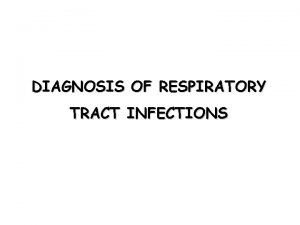Respiratory System Chapter 37 3 Respiratory System n

























- Slides: 25

Respiratory System Chapter 37 -3

Respiratory System n Function: n n Supply oxygen to body tissues Removes carbon dioxide, which is a waste product, from the body tissues.

Purpose of Oxygen n The cells use the oxygen to convert carbohydrates and fats into energy. The byproduct for this process is carbon dioxide, which the body exhales. Cells need oxygen like cars need gas— for energy!

What makes up the respiratory system? n n n nose pharynx larynx trachea bronchi lungs diaphragm

LUNGS n n n Pair of elastic, spongy organs used in breathing and respiration At birth the lungs are pink, but as a person ages, they become gray and mottled from tiny particles breathed in with the air. (why? ) Generally, people who live in cities and industrial areas have darker lungs than those who live in the country


Lungs n n n In the adult human, each lung is 25 to 30 cm (10 to 12 in) long Their movements are controlled by the rib cage and the diaphragm A hiccup is caused by a spasmodic, involuntary contraction of the diaphragm

Take a Breather! n n n An adult normally breathes from 14 to 20 times per minute, but vigorous exercise can raise the rate to 80 breaths per minute A child’s rate of breathing at rest is faster than an adult’s at rest, and a newborn baby has a rate of about 40 breaths per minute. (Why? ) In general, smaller animals have faster breathing rates than larger animals. A rat, for example, breathes about 60 times per minute, while a horse breathes only about 12 times per minute.

Breathing n Divided into two processes: n Inhalation - air is moved into the lungs n Exhalation - air is forced out of the lungs

Inhalation n Diaphragm contracts and flattens pulling air into the lungs. Chest cavity expands to allow space for air. Lungs expand when filled with air.

Inhalation: n n The amount of air normally taken into the lungs in a single breath during quiet breathing is called the tidal volume. In adults the tidal volume is equal to about 0. 5 liters Generally about 4. 8 liters (about 1. 3 gal) – 6 liters in an adult male, but varies from one individual to the next. Athletes can have a vital capacity of as much as 5. 7 liters ( 1. 5 gal) – 7 liters.

Exhalation n n The diaphragm relaxes by moving up to its original position Air is pushed out.

Breathing n n n A person can alter the rate of breathing and can even stop breathing for a short time. But it is impossible to voluntarily stop breathing permanently because breathing, like the heartbeat, is an involuntary activity controlled by nerve centers in the brain stem, the lower part of the brain. These centers are connected with the muscles of the rib cage and diaphragm, and they increase or decrease the rate of breathing according to the needs of the body.

Gas Exchange n n n O 2 diffuses through alveoli into capillaries CO 2 diffuses across in the opposite direction The exchange of gases takes place when air reaches the alveoli.

BREAK!

Pathway 1. Air first passes into the nostrils From there, the air passes through the pharynx, which is shared with the digestive tract. (Why food doesn’t go to the lungs) 2. n The Epiglottis is a flap of tissue that guards the entrance to the trachea, closing when anything is swallowed in order to prevent food or fluid from entering the lungs.

Pathway 3) Air next passes through the larynx n also called the voice box, or vocal cords. The vocal cords are under tension, and a change in tension causes a change in pitch as air passes over them and they vibrate. n An inflammation of the larynx is called laryngitis.

Pathway 4) The larynx trachea, through which the air passes next. n 5) The trachea has rings of cartilage, like the rings in a vacuum cleaner hose, for support. The trachea divides at its bottom end into two bronchi (sing. = bronchus), one to each lung. n Mucus in the bronchi serves to trap and coat dust particles so they don’t scratch or infect the delicate tissues in the lungs.

Lungs structure Anatomy n n The bronchi divide in the lungs into smaller branches called bronchioles. The tiniest bronchioles branch into the alveoli n which are tiny, multi-lobed air sacs n must always stay moist n Special cells in the alveoli secretes moisture and keep them from sticking to each other when the person exhales.

alveoli n The ability to secrete this chemical doesn’t develop until around the eighth or ninth month of pregnancy, so there frequently is a problem in premature babies with the lack of surfactant causing the alveoli to stick together when the baby exhales. n Then, when the baby inhales again, the stuck alveolar cells tear away from their neighbors. n Scar tissue forms at these sites, thus the damage is permanent, and the person’s lungs lose some of their elasticity and ability to expand fully.

How to cure Hiccups ? ? ? n Hiccups n n are spasms of the diaphragm thought to be caused by not enough CO 2 in the body. Thus, hiccups are frequently cured by breathing into a paper bag.

n Bronchitis n n Bacterial Infection of the lungs. Asthma n n is an inflammation of the bronchi, causing them to over -secrete mucus, which in turn, causes coughing to get it up. Pneumonia and Tuberculosis n n Infections is an allergic reaction that causes constriction of the bronchioles, thereby reducing the air passages, thus the amount of air that can get to the alveoli. Emphysema n is a progressive loss of elasticity in the lungs due to rupture of some alveolar walls, coalescing of alveoli, and formation of scar tissue.

Lung Cancer n n Cigarette smoking is a major cause of lung damage. More than 4, 000 substances found in cigarette smoke: n nicotine and carbon monoxide are the most common Nicotine: n Believed responsible for the addictive properties of cigarettes, causes the release of epinephrine, a hormone secreted by the body. n This in turn produces an increase in blood pressure and heart rate. Carbon monoxide: n Prevents the blood from carrying the full amount of oxygen, and over time this can be extremely harmful.

n Lung Cancer Cigarette smoking damages: n the lungs, bronchi, blood vessels, heart and other organs and tissues. n coughing, breathing problems, respiratory infections, pneumonia, stroke, hardening of the arteries ( arteriosclerosis), stomach and intestinal ulcers, and cancer of the mouth, throat, esophagus, kidneys, bladder and pancreas. n Smoking during pregnancy increases the risk of miscarriage and fetal death. Even secondhand smoke has been reported to increase the risk of respiratory and middle ear infections in children and has been related to deaths due to lung cancer and heart disease.

Answer the Following… 1) 2) 3) What happens to the diaphragm during inhalation and exhalation? Describe the pathway air will travel through the respiratory system. How does the circulatory and respiratory system work together to make sure your body gets oxygen and gets rid of carbon dioxide?
 Conducting zone and respiratory zone
Conducting zone and respiratory zone Circularory system
Circularory system Chapter 7:10 respitory system
Chapter 7:10 respitory system Chapter 13 the respiratory system
Chapter 13 the respiratory system Respiratory system
Respiratory system Chapter 15 lesson 2 the respiratory system answer key
Chapter 15 lesson 2 the respiratory system answer key Chapter 7 the respiratory system labeling exercises
Chapter 7 the respiratory system labeling exercises Chapter 34 section 1 the circulatory system
Chapter 34 section 1 the circulatory system Chapter 13 the respiratory system
Chapter 13 the respiratory system Chapter 13 respiratory system figure 13-4
Chapter 13 respiratory system figure 13-4 Chapter 17 respiratory system workbook answers
Chapter 17 respiratory system workbook answers Tiny air sacs at the end of the bronchioles
Tiny air sacs at the end of the bronchioles Circulatory system and respiratory system work together
Circulatory system and respiratory system work together Chapter 16 respiratory emergencies
Chapter 16 respiratory emergencies Chapter 33 circulatory and respiratory systems
Chapter 33 circulatory and respiratory systems Chapter 16 respiratory emergencies
Chapter 16 respiratory emergencies The child with a respiratory disorder chapter 25
The child with a respiratory disorder chapter 25 Bozeman respiratory system
Bozeman respiratory system Unit 9 respiratory system
Unit 9 respiratory system Diagnostic test of respiratory system
Diagnostic test of respiratory system Respiratory system
Respiratory system Membranes and ligaments of larynx
Membranes and ligaments of larynx Respiratory system coloring page
Respiratory system coloring page Respiratory system purpose
Respiratory system purpose Conclusion on respiratory system
Conclusion on respiratory system The energy-releasing process that is fueled by oxygen
The energy-releasing process that is fueled by oxygen




